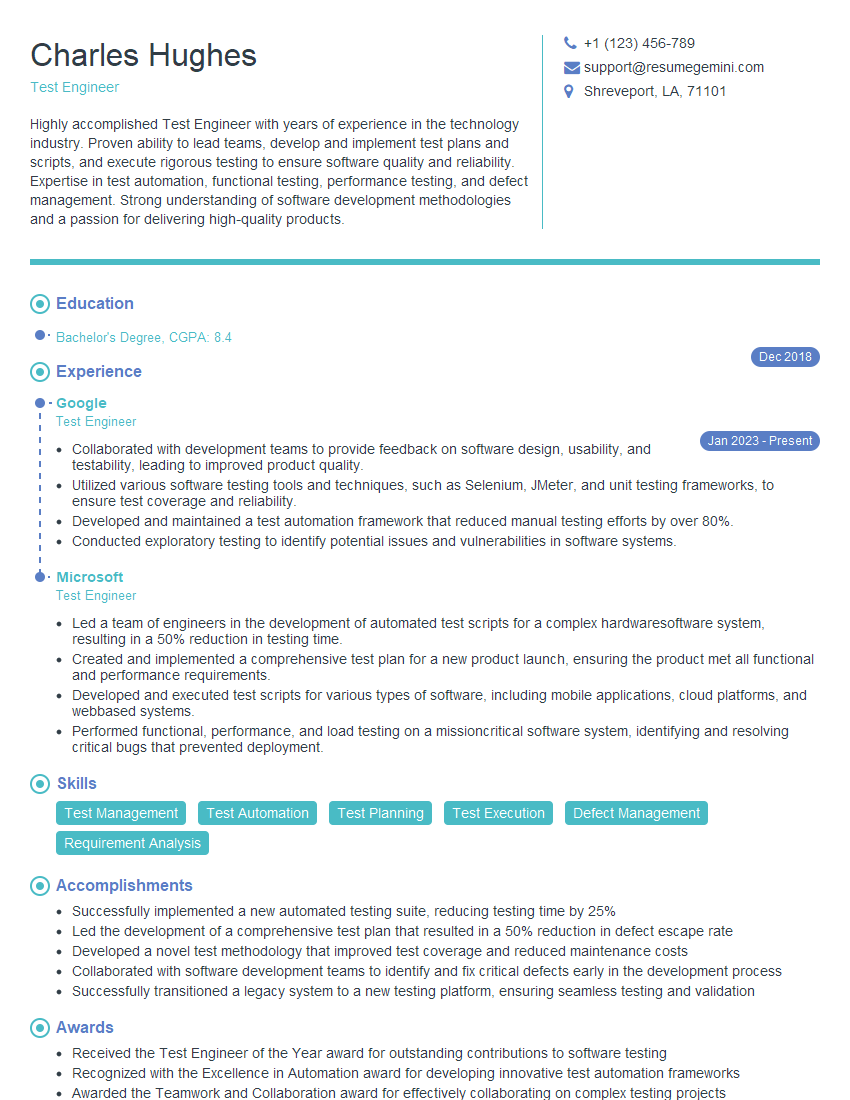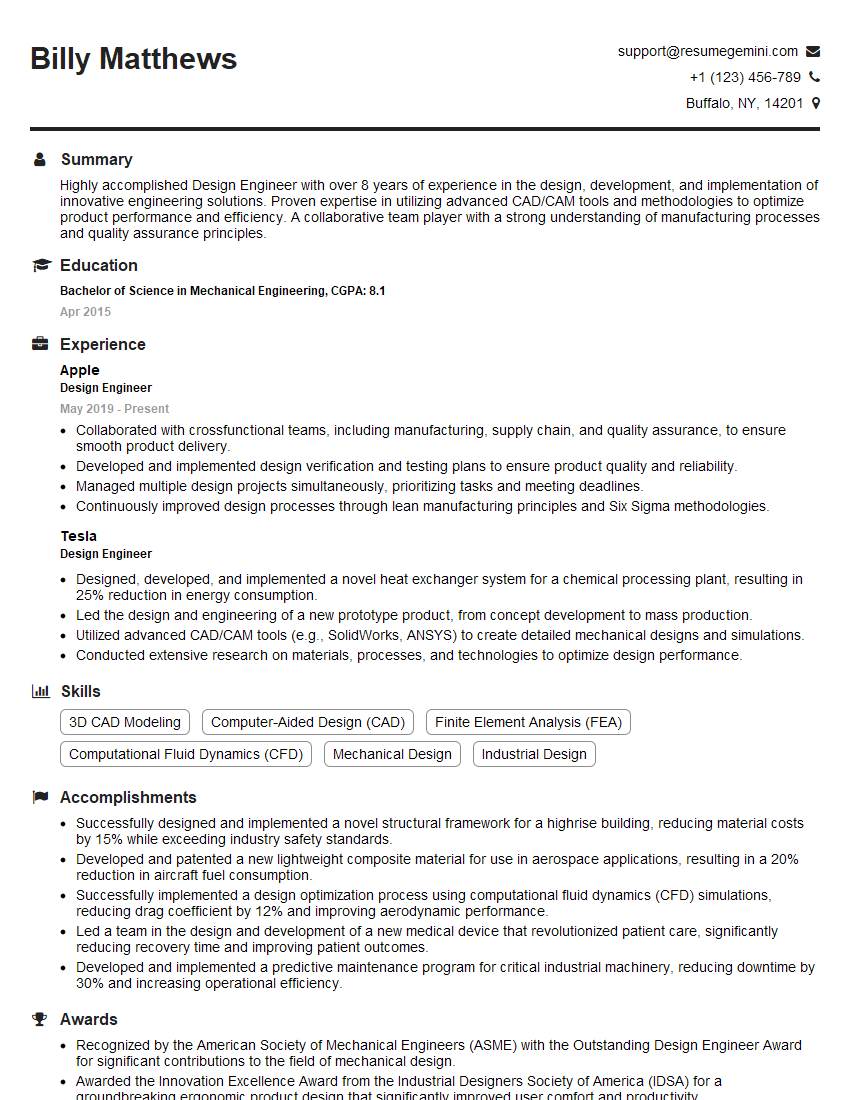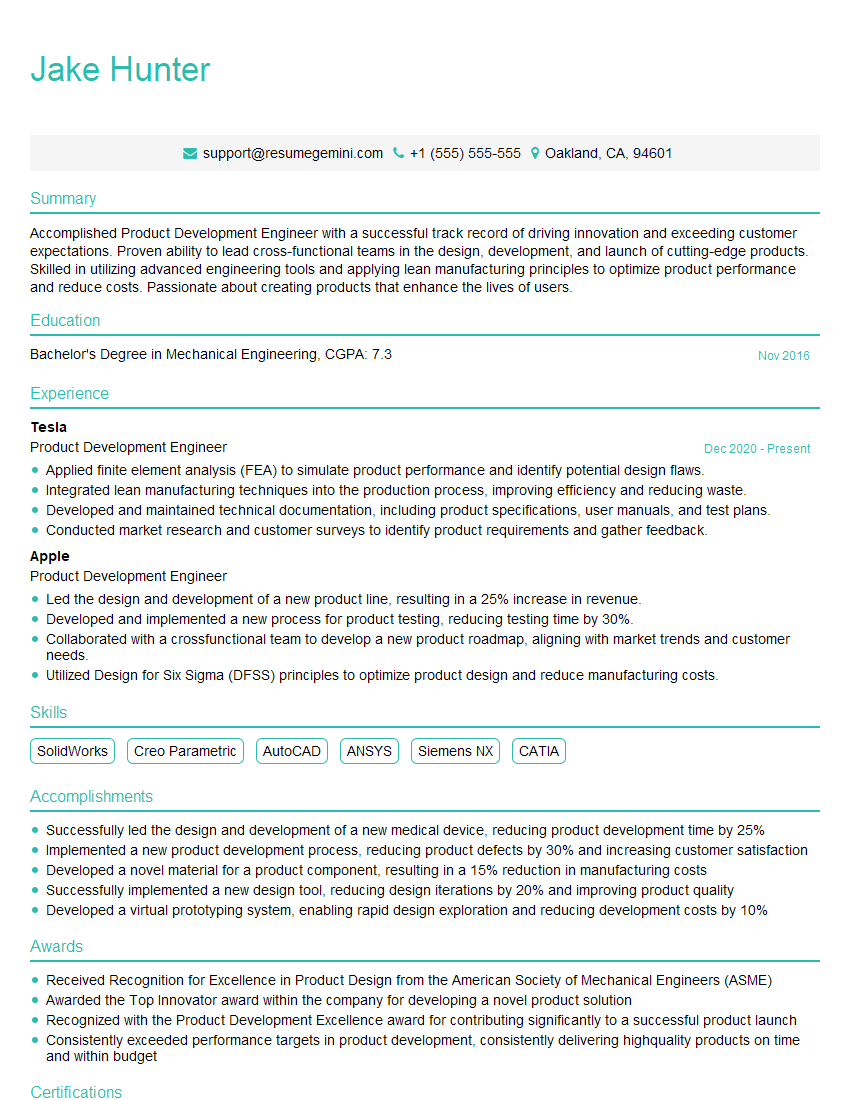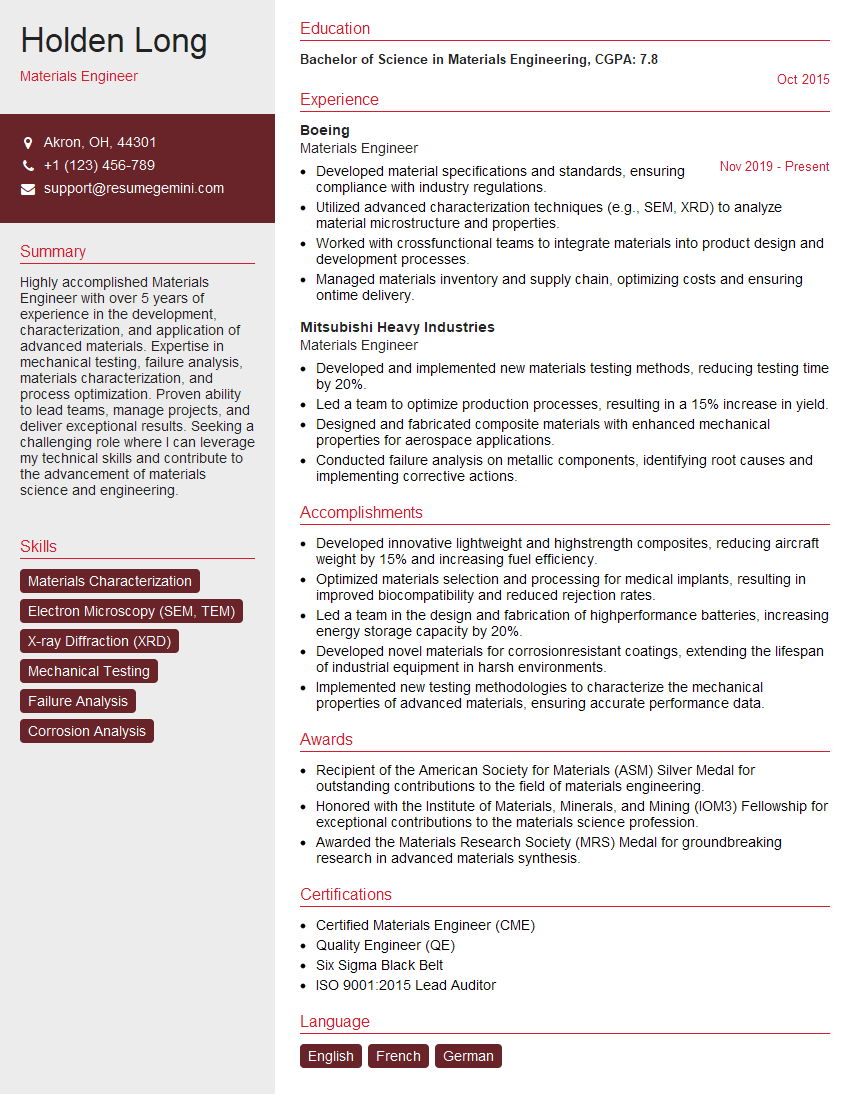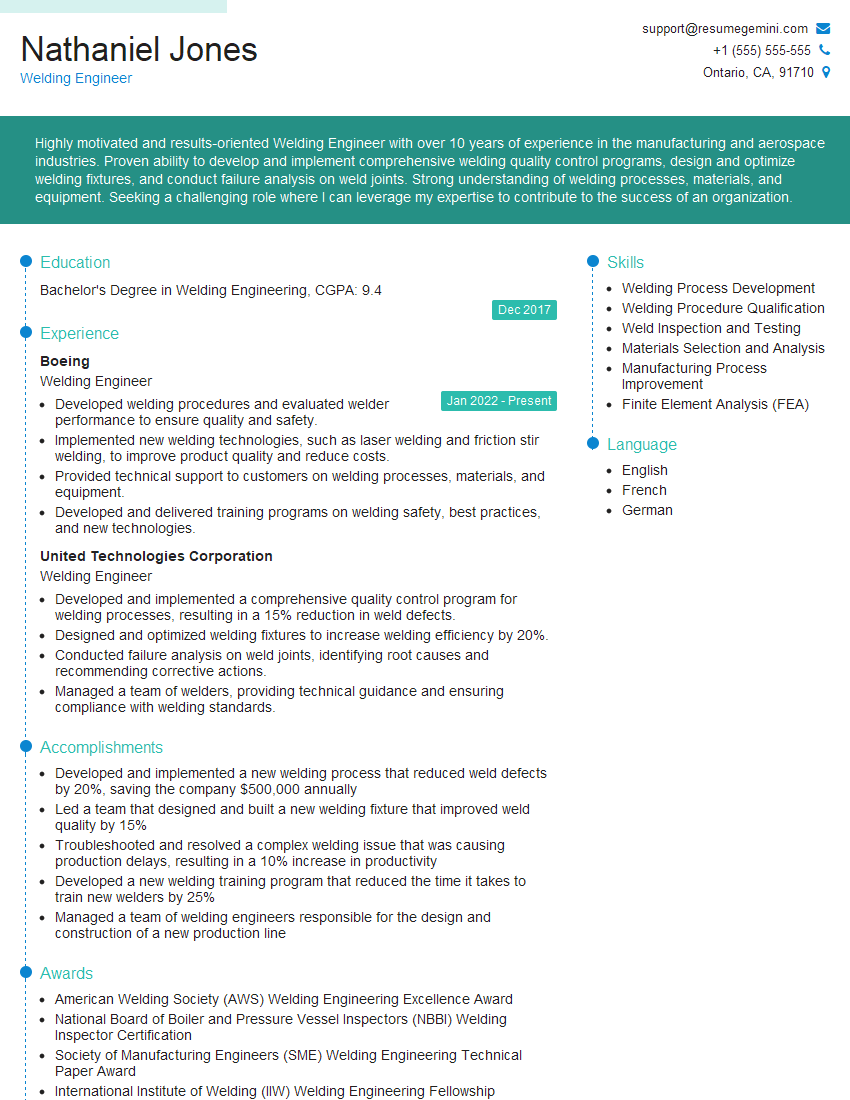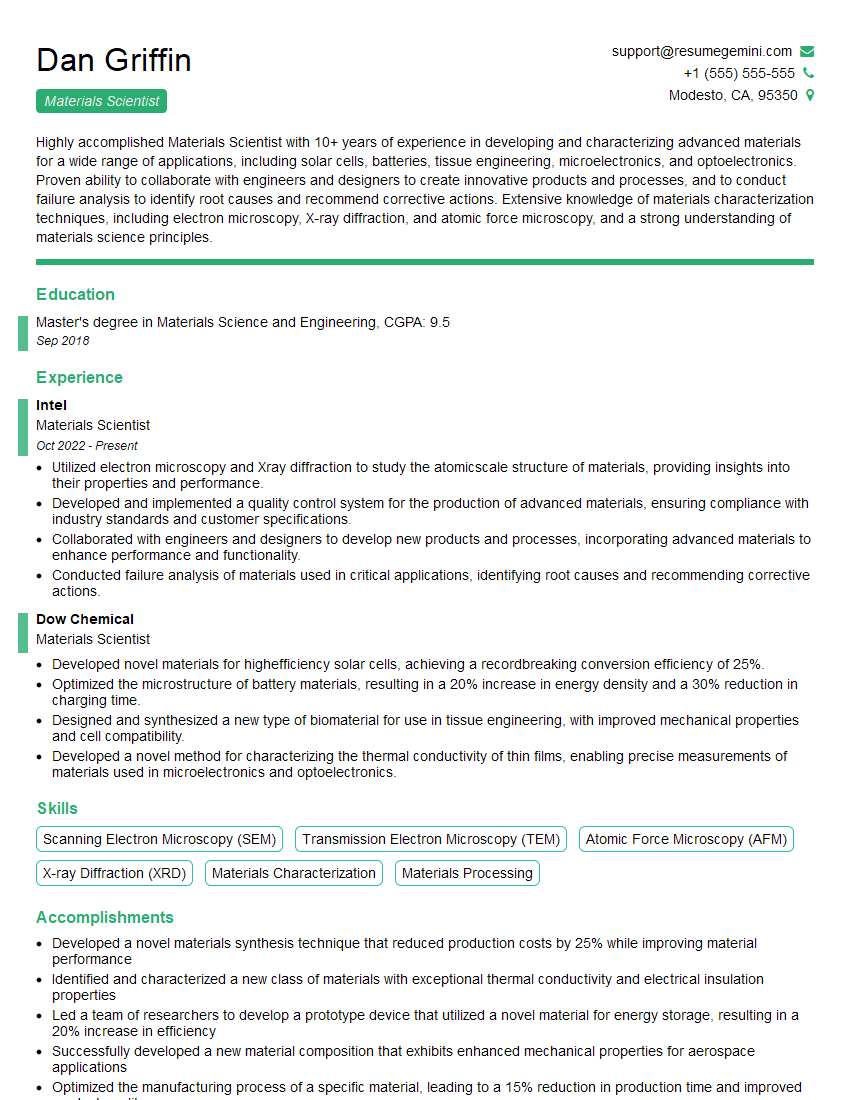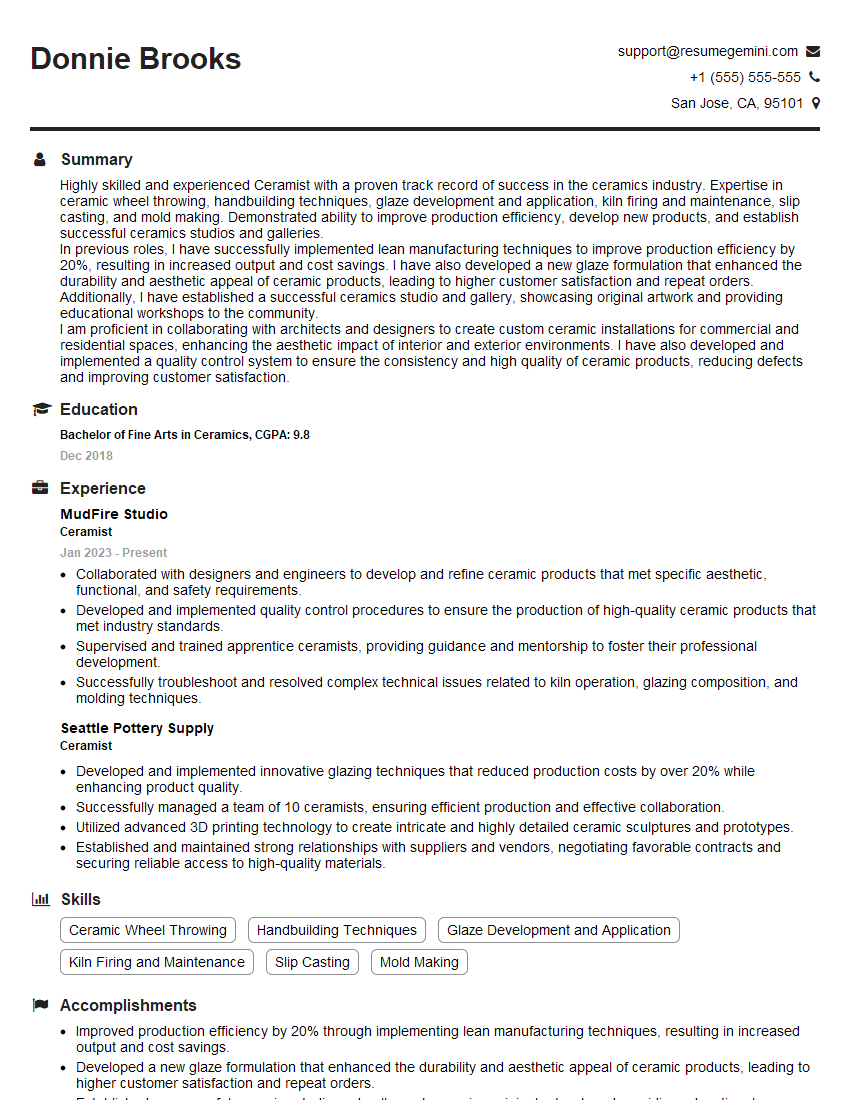Unlock your full potential by mastering the most common Knowledge of Materials and Components interview questions. This blog offers a deep dive into the critical topics, ensuring you’re not only prepared to answer but to excel. With these insights, you’ll approach your interview with clarity and confidence.
Questions Asked in Knowledge of Materials and Components Interview
Q 1. Explain the difference between tensile strength and yield strength.
Tensile strength and yield strength are both crucial measures of a material’s ability to withstand tensile forces (pulling forces), but they represent different points on the material’s stress-strain curve. Tensile strength represents the maximum stress a material can withstand before it fractures or breaks. Yield strength, on the other hand, indicates the stress at which the material begins to deform permanently. Think of it like this: you can stretch a rubber band (elastic deformation) until it reaches its yield strength, after which it won’t return to its original shape. Keep stretching it past the yield point, and eventually, it will break at its tensile strength.
In simpler terms: Tensile strength is the breaking point, while yield strength is the point of permanent deformation.
Example: A steel bar might have a tensile strength of 500 MPa and a yield strength of 350 MPa. This means it can withstand a stress of 350 MPa before permanent deformation occurs, but it will ultimately break at 500 MPa.
Q 2. Describe the various types of material failure modes.
Material failure modes describe how a material breaks down under stress. These modes can be broadly categorized, and often involve a combination of mechanisms:
- Fracture: This involves the separation of a material into two or more pieces. Fracture can be brittle (sudden, without significant deformation, like glass shattering) or ductile (gradual, with significant deformation, like pulling taffy).
- Yielding: Permanent deformation of the material after the yield strength is exceeded. The material doesn’t break, but it’s permanently altered in shape.
- Fatigue: Failure due to repeated cyclic loading, even if the stress level is below the yield strength. Think of a paperclip repeatedly bent back and forth until it breaks.
- Creep: Time-dependent deformation under constant load, especially at high temperatures. Imagine a metal slowly sagging under its own weight over a long period.
- Corrosion: Degradation of a material due to chemical reactions with its environment, leading to weakening and eventual failure. Rusting of iron is a common example.
Understanding these failure modes is critical in designing safe and reliable structures and components. The choice of material and design must consider the expected loading conditions to prevent premature failure.
Q 3. What are the common methods for characterizing material properties?
Characterizing material properties involves a range of experimental techniques to determine their mechanical, thermal, electrical, and other properties. Common methods include:
- Tensile testing: Measures tensile strength, yield strength, elongation, and other mechanical properties by subjecting a specimen to a uniaxial tensile load.
- Hardness testing: Determines the material’s resistance to indentation, using methods like Rockwell, Brinell, or Vickers hardness tests.
- Impact testing: Assesses the material’s ability to absorb impact energy, using tests like Charpy or Izod impact tests. This is especially important for determining a material’s susceptibility to brittle fracture.
- Fatigue testing: Determines the material’s resistance to failure under cyclic loading conditions.
- Creep testing: Measures the time-dependent deformation under constant load and temperature.
- Microscopy (optical, electron): Allows for the examination of the material’s microstructure, which provides insights into its properties and potential failure mechanisms.
- Thermal analysis (DSC, TGA): Used to study thermal transitions and decomposition behavior of materials.
The specific methods used depend on the material and the application. For example, a structural component in an aircraft will undergo rigorous tensile and fatigue testing to ensure its safety.
Q 4. How do you select materials for a specific application?
Material selection for a specific application is a crucial step in engineering design and involves a systematic process. This process involves considering:
- Required Properties: What are the necessary mechanical, thermal, electrical, and chemical properties (strength, stiffness, ductility, conductivity, corrosion resistance, etc.)?
- Operating Conditions: What are the temperature, pressure, corrosive environment, and loading conditions the material will experience?
- Cost: What is the acceptable cost of the material?
- Availability: Is the material readily available?
- Manufacturing Considerations: Can the material be easily fabricated and processed using the available manufacturing techniques?
Example: Designing a car engine requires a material that can withstand high temperatures, pressures, and corrosive environments. Thus, materials like high-strength alloys, often containing specific elements to enhance heat resistance and corrosion resistance, are employed.
Often, a matrix of competing requirements must be addressed and compromises are necessary. Software tools can assist in this selection process.
Q 5. Explain the concept of fatigue and creep in materials.
Fatigue and creep are time-dependent failure mechanisms that significantly affect material performance, especially under sustained loading and elevated temperatures.
Fatigue: This refers to the progressive and localized structural damage that occurs when a material is subjected to cyclic loading. The stress levels involved may be well below the material’s yield strength, but repeated stress cycles can lead to the initiation and propagation of micro-cracks, eventually resulting in catastrophic failure. Think of a wire repeatedly bending – it eventually breaks, even if each bend doesn’t appear to cause significant damage.
Creep: This is the time-dependent permanent deformation of a material under a constant load or stress, particularly at elevated temperatures. At high temperatures, atoms in the material can move more easily, leading to gradual deformation and sagging. This is a major concern in applications like turbine blades in jet engines or high-temperature pipelines.
Understanding fatigue and creep is essential for designing components that will withstand long-term service, especially in demanding environments.
Q 6. Describe the different types of bonding in materials (ionic, covalent, metallic).
Materials are held together by different types of atomic bonding, each with unique characteristics that influence the material’s properties:
- Ionic Bonding: Involves the electrostatic attraction between oppositely charged ions. One atom loses electrons (becoming a positive ion) and another gains electrons (becoming a negative ion). This bond is strong, resulting in materials with high melting points and hardness, but they are often brittle. Example: Sodium chloride (NaCl).
- Covalent Bonding: This involves the sharing of electrons between atoms. This bond is also strong, leading to materials with high melting points and hardness. However, they can be brittle as well. Examples: Diamond (carbon-carbon bonds), Silicon (Si-Si bonds).
- Metallic Bonding: This type of bonding involves a ‘sea’ of delocalized electrons that are shared among a lattice of positive metal ions. This allows for high ductility, malleability, and electrical conductivity. Examples: Copper, Iron, Aluminum.
The type of bonding significantly impacts material properties. For instance, metals are typically ductile and good conductors because of their metallic bonding, while ceramics with ionic or covalent bonds tend to be brittle and insulators.
Q 7. What are the advantages and disadvantages of using composites?
Composites are materials made from two or more constituent materials with significantly different properties, resulting in a material with enhanced characteristics. They combine the advantages of their constituent materials.
Advantages:
- High Strength-to-Weight Ratio: Composites like carbon fiber reinforced polymers (CFRP) offer exceptional strength and stiffness while being lightweight, making them ideal for aerospace and automotive applications.
- Tailored Properties: The properties of a composite can be precisely tuned by adjusting the type and volume fraction of the constituents.
- Corrosion Resistance: Composites can offer excellent corrosion resistance, making them suitable for harsh environments.
- Design Flexibility: Composites can be molded into complex shapes, allowing for intricate designs.
Disadvantages:
- Higher Cost: Composites are generally more expensive to manufacture than traditional materials.
- Complex Manufacturing: The fabrication of composites can be complex and requires specialized equipment.
- Anisotropy: The properties of composites can vary with direction, leading to potential design challenges.
- Damage Tolerance: While strong, composites can be susceptible to damage from impact and fatigue.
Despite the disadvantages, the advantages often outweigh the drawbacks for many high-performance applications, such as aerospace, automotive, and sporting goods.
Q 8. How do you interpret a stress-strain curve?
A stress-strain curve is a graphical representation of a material’s response to applied force. The x-axis represents strain (deformation), and the y-axis represents stress (force per unit area). It reveals crucial material properties.
The initial linear portion shows the elastic region, where the material deforms elastically and returns to its original shape upon unloading. The slope of this region is Young’s modulus (E), indicating the material’s stiffness. Beyond the elastic limit, the material enters the plastic region, where permanent deformation occurs. The yield strength signifies the stress at which permanent deformation begins. The ultimate tensile strength represents the maximum stress the material can withstand before failure. Finally, the curve shows the material’s fracture point where it breaks.
Example: Imagine stretching a rubber band. Initially, it stretches and returns to its original length (elastic region). If you stretch it too far, it remains elongated even after releasing the force (plastic region). Eventually, it snaps (fracture).
Q 9. Explain the role of microstructure in material properties.
Microstructure refers to the arrangement of grains, phases, and defects within a material at a microscopic level. It significantly influences a material’s macroscopic properties such as strength, toughness, ductility, and corrosion resistance. The size, shape, orientation, and distribution of these microstructural features directly impact how the material behaves under stress.
Example: Consider steel. A fine-grained steel (small grains) will generally be stronger and tougher than a coarse-grained steel (large grains) because grain boundaries act as barriers to dislocation movement, which is responsible for plastic deformation. The presence of certain phases, like carbides in steel, can also significantly affect its hardness and strength.
Heat treatments are commonly used to manipulate microstructure. For example, annealing can reduce internal stresses and increase ductility, while quenching and tempering can increase hardness and strength.
Q 10. Describe different types of non-destructive testing methods.
Non-destructive testing (NDT) methods allow us to evaluate material properties without causing damage. Several techniques exist, each with its own advantages and applications:
- Visual inspection: A simple method involving visual examination for cracks, corrosion, or other defects.
- Liquid penetrant testing: A dye is applied to the surface, penetrating any cracks. A developer then draws the dye out, revealing the cracks.
- Magnetic particle testing: Used for ferromagnetic materials. Magnetic particles are applied to the surface, and a magnetic field is induced. Cracks disrupt the magnetic field, causing particles to accumulate, indicating defects.
- Ultrasonic testing: High-frequency sound waves are used to detect internal flaws. Reflections from discontinuities are analyzed to determine their size and location.
- Radiographic testing (X-ray or gamma-ray): Radiation penetrates the material, and variations in density reveal internal defects on a film or digital image.
- Eddy current testing: Electromagnetic induction is used to detect surface and near-surface flaws in conductive materials.
The choice of NDT method depends on the material, the type of defect being sought, and the access to the component.
Q 11. What are some common material degradation mechanisms?
Material degradation refers to the deterioration of a material’s properties over time due to various factors. Common mechanisms include:
- Corrosion: Chemical or electrochemical attack, often involving oxidation.
- Creep: Time-dependent deformation under constant stress, especially at high temperatures.
- Fatigue: Failure due to repeated cyclic loading, even at stresses below the yield strength.
- Wear: Material loss due to surface contact and friction.
- Stress corrosion cracking: Cracking caused by the combined action of tensile stress and a corrosive environment.
- Hydrogen embrittlement: Reduction in ductility and strength due to the absorption of hydrogen.
Understanding these mechanisms is crucial for designing materials and components with extended lifetimes.
Q 12. How do you determine the appropriate material for a high-temperature application?
Selecting a material for high-temperature applications requires considering several factors. The primary concern is maintaining sufficient strength and stability at elevated temperatures. Key properties to evaluate include:
- Melting point: The material should have a significantly higher melting point than the operating temperature.
- Creep resistance: The material should exhibit minimal time-dependent deformation at the operating temperature.
- Oxidation resistance: Resistance to oxidation and other chemical degradation at high temperatures is crucial.
- Thermal shock resistance: Ability to withstand rapid temperature changes without cracking or failure.
- Thermal conductivity: Depending on the application, high or low thermal conductivity may be desired.
Superalloys, ceramics, and certain polymers are often used in high-temperature applications due to their excellent properties at elevated temperatures. The specific choice depends on the exact operating conditions and performance requirements.
Q 13. Explain the difference between ductile and brittle materials.
Ductile and brittle materials differ significantly in their response to stress:
- Ductile materials deform extensively before fracture, exhibiting significant plastic deformation. They show a considerable elongation and reduction in area before failure. Examples include mild steel, aluminum, and copper.
- Brittle materials exhibit little to no plastic deformation before fracture. They fracture suddenly with minimal warning. Examples include ceramics, cast iron, and some types of glass.
This difference stems from the material’s microstructure and the way dislocations move within the material. Ductile materials allow for dislocation movement, accommodating plastic deformation. Brittle materials lack this ability, leading to immediate fracture when stress exceeds the material’s strength.
Q 14. What are the factors to consider when selecting a material for corrosion resistance?
Selecting a material for corrosion resistance necessitates considering various factors:
- Environment: The specific corrosive environment (e.g., acidic, alkaline, saltwater) dictates the material’s suitability. Different materials exhibit varying resistance to different corrosive agents.
- Temperature: Temperature influences corrosion rates. Higher temperatures generally accelerate corrosion.
- Stress: Tensile stresses can increase susceptibility to stress corrosion cracking.
- Material properties: Consider inherent corrosion resistance (e.g., stainless steels, titanium, certain polymers). Passivation (the formation of a protective oxide layer) plays a crucial role in corrosion resistance.
- Cost: High corrosion resistance often comes with a higher material cost.
A thorough understanding of the corrosive environment and the material’s electrochemical properties is crucial for selecting the appropriate corrosion-resistant material.
Q 15. Describe different types of polymers and their applications.
Polymers are large molecules composed of repeating structural units called monomers. Their properties and applications are incredibly diverse, depending on the type of monomer, the way the monomers are linked, and any added fillers or modifiers.
- Thermoplastics: These polymers soften when heated and can be repeatedly molded or shaped. Think of everyday plastics like polyethylene (PE) used in plastic bags and bottles, or polypropylene (PP) found in containers and fibers. Their reusability is a key advantage.
- Thermosets: Unlike thermoplastics, thermosets undergo irreversible chemical changes upon heating, forming a rigid, cross-linked structure. Once cured, they cannot be remelted. Examples include epoxy resins used as adhesives and coatings, and phenolic resins used in electrical insulators. Their high strength and resistance to heat make them ideal for certain applications.
- Elastomers: These polymers exhibit significant elasticity and can be stretched repeatedly. Natural rubber and synthetic rubbers like styrene-butadiene rubber (SBR) in tires are prime examples. Their flexibility and resilience are critical to their function.
- Specialty Polymers: This category includes materials with specific properties tailored for niche applications, such as fluoropolymers (like Teflon) known for their non-stick and chemical resistance, or polyimides used in high-temperature applications due to their exceptional thermal stability.
The choice of polymer depends heavily on the desired properties and application. For instance, if flexibility and impact resistance are crucial, an elastomer might be preferred; if high temperature resistance is needed, a thermoset or specialty polymer would be more suitable. Selecting the right polymer is a crucial part of material science and engineering.
Career Expert Tips:
- Ace those interviews! Prepare effectively by reviewing the Top 50 Most Common Interview Questions on ResumeGemini.
- Navigate your job search with confidence! Explore a wide range of Career Tips on ResumeGemini. Learn about common challenges and recommendations to overcome them.
- Craft the perfect resume! Master the Art of Resume Writing with ResumeGemini’s guide. Showcase your unique qualifications and achievements effectively.
- Don’t miss out on holiday savings! Build your dream resume with ResumeGemini’s ATS optimized templates.
Q 16. What are the key considerations for joining different materials?
Joining different materials requires careful consideration of several factors to ensure a strong, reliable bond. The key aspects include:
- Material Compatibility: The materials being joined must be compatible chemically and physically. For example, joining dissimilar metals might require careful surface preparation to prevent galvanic corrosion.
- Surface Preparation: Cleanliness and surface roughness are paramount. Contamination can weaken the joint, while proper surface treatment (e.g., etching, sanding) can enhance adhesion.
- Joining Method: The choice of joining method depends on material properties, required strength, and application. Options include adhesives, welding (fusion bonding), soldering, brazing, mechanical fasteners (bolts, screws, rivets), and more.
- Joint Design: The geometry of the joint significantly influences its strength and durability. Factors like overlap area, stress concentration points, and joint configuration should be carefully considered.
- Environmental Considerations: The joint’s performance in service conditions needs evaluation. Factors such as temperature, humidity, and exposure to chemicals can impact the bond strength and durability.
For instance, joining aluminum to steel might require a strong adhesive due to dissimilar metal challenges, while welding would be suitable for joining two pieces of steel with high strength requirements. Improper selection can lead to premature failure of the joined components.
Q 17. How do you assess the impact of environmental factors on material performance?
Assessing the impact of environmental factors on material performance involves understanding how various environmental stressors can degrade material properties over time. This often necessitates accelerated testing and careful data analysis.
- Temperature: High temperatures can lead to thermal degradation, while low temperatures can cause embrittlement. Thermal cycling (repeated heating and cooling) can accelerate these effects.
- Humidity: Moisture can cause corrosion in metals, swelling in polymers, and degradation of composite materials. High humidity can exacerbate many degradation processes.
- UV Radiation: UV light from sunlight can cause photodegradation, weakening and degrading polymers and some coatings.
- Chemical Exposure: Contact with certain chemicals can cause corrosion, dissolution, or other forms of degradation depending on the material and chemical nature.
We often use accelerated testing techniques like UV exposure chambers to simulate years of outdoor exposure in a much shorter timeframe, or salt spray tests to accelerate corrosion in metals. Data from these tests helps us predict material lifespan and make informed material selection decisions for a given environment.
Q 18. Explain the principles of heat treatment on metals.
Heat treatment modifies the microstructure of metals, altering their mechanical properties (strength, hardness, ductility) by controlling the heating and cooling rates. This is achieved by manipulating the phases present within the metal’s structure.
- Annealing: This involves heating the metal to a specific temperature, holding it for a time, and then slowly cooling. It relieves internal stresses, softens the material, and improves ductility. Think of it as relaxing the metal after working it.
- Quenching: This involves rapidly cooling a heated metal, usually in water or oil. This process traps high-temperature phases, leading to increased hardness and strength, but often at the expense of ductility. It’s commonly used to harden steel.
- Tempering: This follows quenching and involves reheating to a lower temperature, followed by slow cooling. It reduces brittleness introduced by quenching while retaining some of the increased hardness.
- Normalizing: This involves heating to a higher temperature than annealing and cooling in still air. It refines the grain structure, improving homogeneity and mechanical properties.
Consider a knife blade: the steel is heat-treated to achieve a hard, sharp cutting edge (quenching), yet it’s not too brittle (tempering). The process is carefully controlled to achieve the desired balance of properties.
Q 19. What are the limitations of different material testing techniques?
Material testing techniques, while invaluable, have limitations that must be acknowledged to avoid misinterpretations.
- Tensile Testing: While widely used to assess strength and ductility, it only provides information under uniaxial loading and might not accurately reflect real-world multiaxial stress states.
- Impact Testing: Useful for measuring toughness and resistance to fracture under impact loads, but the results are sensitive to the test configuration and may not be representative of all impact scenarios.
- Fatigue Testing: This assesses the material’s resistance to cyclic loading, essential for components under repeated stress. However, it can be time-consuming and expensive, and testing parameters must be carefully chosen to reflect service conditions accurately.
- Creep Testing: Measures the material’s deformation under sustained high temperatures and stresses. It is time-intensive and requires specialized equipment.
- Hardness Testing: Provides a simple measure of a material’s resistance to indentation. It’s widely used, but the hardness value is not always directly correlated to other mechanical properties.
It’s crucial to select appropriate testing methods that reflect the intended application and to understand the limitations of each technique. Using multiple tests can help to get a more comprehensive understanding of the material’s behavior.
Q 20. Describe the concept of material compatibility.
Material compatibility refers to the ability of two or more materials to coexist without detrimental interaction under specified conditions. This is vital in many engineering applications where different materials are in contact.
Incompatibility can manifest in several ways:
- Galvanic Corrosion: When dissimilar metals are in contact in the presence of an electrolyte (like moisture), the more active metal corrodes preferentially. This is often seen in steel and aluminum structures.
- Stress Corrosion Cracking: A combination of tensile stress and a corrosive environment can lead to cracking and failure, even in materials normally resistant to either stress or corrosion alone.
- Chemical Reactions: Incompatible materials can react chemically, leading to degradation or the formation of undesirable compounds.
- Diffusion: Atoms from one material can diffuse into another, altering the properties of both materials. This can weaken the interface between materials.
Proper material selection, surface treatments, and barrier coatings are essential in ensuring material compatibility. For example, using a protective coating on a metal to prevent corrosion or selecting compatible polymers in contact with sensitive electronic components are crucial to avoid failure.
Q 21. How do you troubleshoot a material failure in a product?
Troubleshooting a material failure requires a systematic approach to identify the root cause. A common framework involves:
- Visual Inspection: Carefully examine the failed component to identify the location and nature of the failure (e.g., crack, fracture, corrosion).
- Gather Information: Collect data on the operating conditions, service history, and environmental factors that the component was exposed to.
- Material Characterization: Perform tests (e.g., microscopy, chemical analysis) to determine the material’s composition and microstructure. Look for signs of degradation or anomalies.
- Failure Analysis: Analyze the fracture surface, using techniques like fractography, to understand the mode of failure (e.g., brittle, ductile, fatigue). This can provide clues about the stresses involved and possible causes.
- Root Cause Determination: Based on the gathered information and analysis, determine the underlying cause of the failure. This could be due to material defects, design flaws, manufacturing errors, or environmental factors.
- Corrective Actions: Implement solutions to prevent similar failures in the future. This might include modifying the design, improving manufacturing processes, selecting more suitable materials, or altering operating conditions.
For example, a fractured component might exhibit fatigue striations on its fracture surface, indicating cyclic loading was the cause of failure. Identifying the source of these cyclic loads and mitigating them would be a key corrective action.
Q 22. What is the difference between amorphous and crystalline materials?
The key difference between amorphous and crystalline materials lies in the arrangement of their atoms or molecules. Crystalline materials have a highly ordered, repeating atomic structure extending in three dimensions, like a perfectly organized brick wall. This long-range order leads to distinct properties like sharp melting points and anisotropic behavior (properties vary with direction). Examples include metals, many ceramics, and some polymers. Amorphous materials, on the other hand, lack this long-range order. Their atoms are arranged randomly, like a pile of randomly thrown bricks. This results in properties like a gradual softening range rather than a sharp melting point and isotropic behavior (properties are consistent in all directions). Examples include glass, many plastics, and some rapidly cooled metals.
- Crystalline: Think of a perfectly aligned salt crystal – each sodium and chloride ion is precisely placed in a repeating pattern.
- Amorphous: Imagine a glass of water – the water molecules are randomly distributed and don’t exhibit a long-range order.
Q 23. How do you evaluate the cost-effectiveness of different materials?
Evaluating the cost-effectiveness of materials requires a holistic approach, considering not just the initial material cost but also factors like processing costs, performance over the material’s lifespan, and environmental impact. A simple cost comparison is insufficient. A thorough analysis involves:
- Initial Material Cost: The price per unit volume or weight.
- Processing Costs: Manufacturing, forming, and finishing costs (e.g., machining, coating).
- Performance and Durability: Considering the material’s strength, corrosion resistance, wear resistance, and expected lifespan to determine the long-term cost per unit of functionality. A more expensive material might be cost-effective if it lasts significantly longer.
- Environmental Impact: Embodied energy (energy used in production), recyclability, and disposal costs. Sustainable materials may have higher initial costs but reduce long-term environmental expenses.
- Maintenance Costs: Consider the frequency and cost of repairs or replacements due to material degradation.
For example, comparing aluminum and steel for an automotive part, steel might have a lower initial cost, but aluminum’s lighter weight could improve fuel efficiency, offsetting the higher initial price over the vehicle’s lifetime.
Q 24. Explain the role of surface treatments in enhancing material properties.
Surface treatments significantly alter a material’s surface properties, thereby improving its overall performance and lifespan. These treatments can enhance:
- Corrosion Resistance: Coatings like galvanizing (zinc coating on steel) protect against oxidation and rust.
- Wear Resistance: Hard coatings (e.g., nitriding, hard chrome plating) increase surface hardness and reduce friction, extending the life of components in high-wear applications.
- Adhesion: Surface treatments can improve the bonding between materials, such as primers before painting.
- Biocompatibility: In medical implants, surface treatments can enhance biocompatibility to reduce tissue rejection.
- Aesthetics: Anodizing aluminum creates a colorful and corrosion-resistant surface finish.
The choice of surface treatment depends on the specific application and required properties. For example, a biomedical implant requires biocompatible and corrosion-resistant coatings, whereas a cutting tool needs a hard and wear-resistant surface.
Q 25. Describe your experience with specific material characterization techniques (e.g., SEM, XRD, TEM).
I have extensive experience utilizing various material characterization techniques. My work has involved:
- Scanning Electron Microscopy (SEM): Used extensively for high-resolution imaging of material surfaces, revealing surface morphology, grain structure, and the presence of defects. I have used SEM to analyze fracture surfaces to understand failure mechanisms in components.
- X-ray Diffraction (XRD): Applied to identify crystalline phases present in a material, determine crystal structure, and quantify the relative amounts of different phases. This technique was crucial in determining the degree of crystallinity in a polymer blend project.
- Transmission Electron Microscopy (TEM): Used for analyzing the microstructure at the nanoscale, including crystal defects, grain boundaries, and even atomic arrangements. My research involved using TEM to study the structure of nanocomposites.
Data analysis from these techniques often involves image processing and diffraction pattern analysis using specialized software, ensuring accurate and reliable results that inform material selection and design decisions.
Q 26. Explain the concept of phase diagrams and their use in materials selection.
Phase diagrams are graphical representations of the equilibrium relationships between phases (solid, liquid, gas) in a material system as a function of temperature, composition, and pressure (usually pressure is held constant). They are essential tools in materials selection because they predict phase transformations, helping us choose materials with the desired microstructure and properties. For example, the iron-carbon phase diagram is crucial in understanding the different steels and their properties.
By understanding the phase diagram, we can predict the microstructure obtained by different processing methods like heat treatments. For instance, we can determine the appropriate temperature and cooling rate to obtain a specific microstructure with the required mechanical properties. Furthermore, phase diagrams can help in predicting the solubility limits of one element in another, allowing for the selection of materials with specific compositional requirements.
The diagram visually shows regions of stability for different phases, solid solution regions, eutectic points (where three phases coexist at equilibrium), and other critical points. This allows for informed material selection based on the required properties and processing conditions.
Q 27. How do you determine the appropriate safety factors when designing with materials?
Determining appropriate safety factors in material design is critical for ensuring component reliability and preventing catastrophic failures. The safety factor is a multiplier applied to the calculated design stress to account for uncertainties and variations in material properties, loading conditions, and manufacturing tolerances. It’s not simply a single number but depends heavily on several crucial considerations:
- Material Properties: Variations in material strength, stiffness, and other properties need consideration; data from multiple samples and statistical analysis are key.
- Load Uncertainty: The actual loads applied to the component can deviate from the design loads due to unforeseen circumstances; appropriate estimations of the maximum possible load are essential.
- Environmental Effects: Factors like temperature, corrosion, and fatigue weaken components; these factors should be accounted for.
- Consequences of Failure: The severity of failure determines the safety factor. A small failure with minimal impact needs a smaller safety factor than a catastrophic failure.
- Industry Standards and Regulations: Many industries adhere to specific safety standards and codes that dictate minimum safety factors.
The safety factor is a balance between ensuring safety and avoiding overdesign. It’s determined through a combination of engineering judgment, analysis of risk, and adherence to relevant standards. A thorough understanding of the application and the potential consequences of failure is crucial.
Q 28. Describe a situation where your knowledge of materials helped solve a problem.
In a previous project involving the design of a high-temperature component for an aerospace application, we initially selected a nickel-based superalloy due to its excellent high-temperature strength. However, during testing, we discovered unexpected cracking at elevated temperatures. My understanding of materials science led me to investigate the material’s microstructure. Using SEM and TEM, I found the formation of brittle intermetallic phases at the grain boundaries, contributing to the cracking. This understanding allowed us to modify the alloy’s composition slightly, reducing the formation of these undesirable phases. Further testing of the redesigned component showed significant improvement in high-temperature performance and crack resistance, solving the problem and ensuring the component’s reliability.
Key Topics to Learn for Knowledge of Materials and Components Interview
- Material Properties: Understanding mechanical properties (strength, stiffness, ductility), thermal properties (conductivity, expansion), electrical properties (conductivity, resistivity), and chemical properties (corrosion resistance, reactivity). Consider how these properties influence material selection for specific applications.
- Material Selection: Developing a systematic approach to choosing the right material for a given design constraint, considering factors like cost, performance, availability, and environmental impact. Practice applying this to various engineering challenges.
- Manufacturing Processes: Familiarize yourself with common manufacturing techniques relevant to your field (e.g., casting, forging, machining, additive manufacturing) and their effect on the final material properties and component performance.
- Failure Analysis: Learn to identify common failure mechanisms in materials and components (e.g., fatigue, creep, fracture) and understand how to prevent them through proper material selection, design, and processing.
- Component Design Considerations: Explore the interplay between material properties and component design. Understand concepts like stress analysis, fatigue life prediction, and the impact of geometry on component performance.
- Testing and Characterization: Become familiar with various material testing techniques (e.g., tensile testing, hardness testing, impact testing) used to determine material properties and ensure quality control.
- Advanced Materials: Depending on your specialization, research and understand the properties and applications of advanced materials like composites, polymers, ceramics, or nanomaterials.
Next Steps
Mastering Knowledge of Materials and Components is crucial for career advancement in engineering and related fields. A strong understanding of these concepts opens doors to exciting opportunities and positions you as a valuable asset to any team. To maximize your job prospects, it’s essential to present your skills effectively. Creating an ATS-friendly resume is key to getting your application noticed. ResumeGemini can help you build a professional, impactful resume that highlights your expertise in Knowledge of Materials and Components. ResumeGemini provides examples of resumes tailored to this specific field, ensuring your application stands out. Take the next step towards your dream career by crafting a compelling resume with ResumeGemini today.
Explore more articles
Users Rating of Our Blogs
Share Your Experience
We value your feedback! Please rate our content and share your thoughts (optional).
What Readers Say About Our Blog
This was kind of a unique content I found around the specialized skills. Very helpful questions and good detailed answers.
Very Helpful blog, thank you Interviewgemini team.

